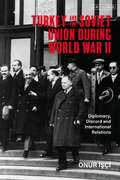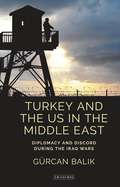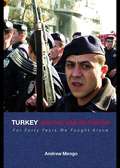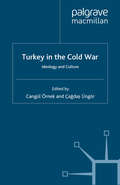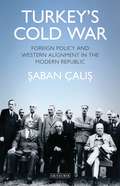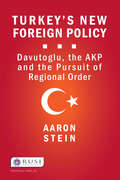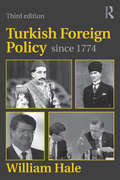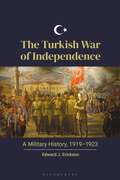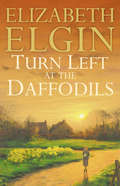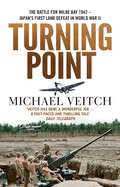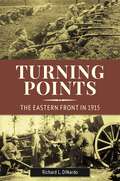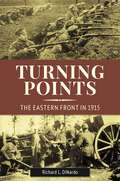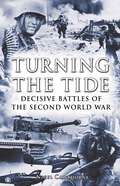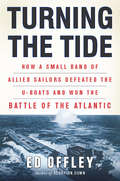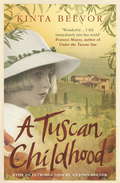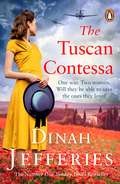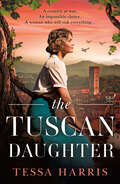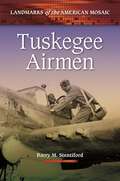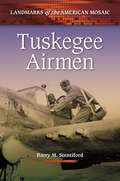- Table View
- List View
Turkey and the Soviet Union During World War II: Diplomacy, Discord and International Relations (Library of World War II Studies)
by Onur IsciBased on newly accessible Turkish archival documents, Onur Isci's study details the deterioration of diplomatic relations between Turkey and the Soviet Union during World War II. Turkish-Russian relations have a long history of conflict. Under Ataturk relations improved – he was a master 'balancer' of the great powers. During the Second World War, however, relations between Turkey and the Soviet Union plunged to several degrees below zero, as Ottoman-era Russophobia began to take hold in Turkish elite circles. For the Russians, hostility was based on long-term apathy stemming from the enormous German investment in the Ottoman Empire; for the Turks, on the fear of Russian territorial ambitions. This book offers a new interpretation of how Russian foreign policy drove Turkey into a peculiar neutrality in the Second World War, and eventually into NATO. Onur Isci argues that this was a great reversal of Ataturk-era policies, and that it was the burden of history, not realpolitik, that caused the move to the west during the Second World War.
Turkey and the US in the Middle East: Diplomacy and Discord during the Iraq Wars (Contemporary Turkey)
by Gürcan BalikTurkey's recent foreign policy has led to fractious relations with countries in the Middle East and the US. Written by the former chief foreign policy advisor to the Turkish president and based on unprecedented access to official documents and communiqués, this book gives the inside story of Turkish–US relations from the first Gulf War, through debates on the Iraqi Kurdish question, the 2003 invasion of Iraq and into the present day. Using events in Iraq as the basis for a theoretical case study, Gürcan Balik argues that Turkey influenced US foreign policy on several key occasions, and that Turkish support was instrumental in the first intervention in Iraq. After Iraq's 1991 uprisings, however, Turkey's interests in the Middle East began to diverge from those of the US, and their relationship gradually deteriorated, evident in Turkey's refusal to open up its northern border to aid the US advance to Baghdad in 2003. Balik contends that an 'Iraq gap' then emerged, which has since had major implications for the Turkish economy and for the future of the Middle East. Turkey and the US in the Middle East contains hitherto unpublished primary source material, and is an essential addition to the scholarship of the period.'Balik's work is one of the most detailed studies detailing how the Iraq Wars tested U.S.–Turkish relations, twice. A must read for anyone seeking to understand Turkish foreign policy today and the future of U.S.–Turkish ties.'Soner Cagaptay, Beyer Family Fellow and Director of Turkish Research Program, Washington Institute for Near East Policy'This excellent book provides a wealth of empirical evidence and detailed policy analysis on how the two Iraq wars have become the center of gravity in Turkish–American relations in the post-Cold War era. As a scholar-practitioner who served at the commanding heights of Turkish foreign policy, Gürcan Balik, has produced an essential account for both researchers and policy makers.' Omer Taspinar, Brookings Institution and National Defense University
Turkey and the War on Terror: 'For Forty Years We Fought Alone' (Contemporary Security Studies)
by Andrew MangoSince the 1970s, Turkey has suffered 35,000 deaths through terrorism, yet the PKK terror group was only recognized as such by the European Union in 2002. The realization that terrorism poses a world-wide threat is now forcing a keen reassessment of the struggle which Turkey has had to wage with terror for over thirty years while the world looked on. Terror is clearly now a key part of the international agenda and this authoritative account details and establishes the Turkish experience. This chronological account of terrorist attacks inside Turkey and against Turkish targets outside the country, places them in the global setting. This book will be of great interest to all students and scholars of international relations, terrorism and security studies.
Turkey and the War on Terror: 'For Forty Years We Fought Alone' (Contemporary Security Studies)
by Andrew MangoSince the 1970s, Turkey has suffered 35,000 deaths through terrorism, yet the PKK terror group was only recognized as such by the European Union in 2002. The realization that terrorism poses a world-wide threat is now forcing a keen reassessment of the struggle which Turkey has had to wage with terror for over thirty years while the world looked on. Terror is clearly now a key part of the international agenda and this authoritative account details and establishes the Turkish experience. This chronological account of terrorist attacks inside Turkey and against Turkish targets outside the country, places them in the global setting. This book will be of great interest to all students and scholars of international relations, terrorism and security studies.
Turkey in the Cold War: Ideology and Culture
by Cangül Örnek and Çağdaş ÜngörThis volume examines the cultural and ideological dimensions of the Cold War in Turkey. Departing from the conventional focus on diplomacy and military, the collection focuses on Cold War's impact on Turkish society and intellectuals. It includes chapters on media and propaganda, literature, sports, as well as foreign aid and assistance.
Turkey’s Cold War: Foreign Policy and Western Alignment in the Modern Republic (Contemporary Turkey)
by Saban Halis ÇalisSince the end of the Ottoman Empire, Turkey has repeatedly attempted to assert its position as a central strategic nation in the formation of world geo-politics. Turkey's Cold War shows for the first time how the country's modern foreign policy, in particular during the Cold War, has been shaped by an aspiration to become part of the Western world.
Turkey's New Foreign Policy: Davutoglu, the AKP and the Pursuit of Regional Order (Whitehall Papers)
by Aaron SteinTurkey’s Justice and Development Party (AKP), after coming to power in 2002, sought to play a larger diplomatic role in the Middle East. The AKP adopted a proactive foreign policy to create ‘strategic depth’ by expanding Turkey’s zone of influence in the region, drawing on the opportunities of geography, economic power and imperial history to reconnect the country with its historical hinterland. Yet despite early promise, this policy came undone after the Arab upheavals of 2011 and has seen Turkey increasingly at odds with its neighbours and the West. Turkey's New Foreign Policy outlines the key tenets of the AKP’s policy of strategic depth in the Middle East and how this marks a departure from traditional Turkish foreign policy. Particular attention is focused on the Turkish reaction to the political changes that swept through the Arab world – including the Syrian civil war – and presented Turkey with its most significant foreign-policy challenge to date. Based on extensive primary research of Turkish-language sources, this monograph argues that political changes in the Middle East have precipitated a serious decline in Turkish regional influence, reversing earlier gains in influence after the AKP came to power. However, despite these foreign-policy defeats, the AKP has shown little indication that it is willing to scale back its ambitions, insisting that it stands on the right side of history – drawing a clear distinction between Turkey and the West.
Turkey's New Foreign Policy: Davutoglu, the AKP and the Pursuit of Regional Order (Whitehall Papers)
by Aaron SteinTurkey’s Justice and Development Party (AKP), after coming to power in 2002, sought to play a larger diplomatic role in the Middle East. The AKP adopted a proactive foreign policy to create ‘strategic depth’ by expanding Turkey’s zone of influence in the region, drawing on the opportunities of geography, economic power and imperial history to reconnect the country with its historical hinterland. Yet despite early promise, this policy came undone after the Arab upheavals of 2011 and has seen Turkey increasingly at odds with its neighbours and the West. Turkey's New Foreign Policy outlines the key tenets of the AKP’s policy of strategic depth in the Middle East and how this marks a departure from traditional Turkish foreign policy. Particular attention is focused on the Turkish reaction to the political changes that swept through the Arab world – including the Syrian civil war – and presented Turkey with its most significant foreign-policy challenge to date. Based on extensive primary research of Turkish-language sources, this monograph argues that political changes in the Middle East have precipitated a serious decline in Turkish regional influence, reversing earlier gains in influence after the AKP came to power. However, despite these foreign-policy defeats, the AKP has shown little indication that it is willing to scale back its ambitions, insisting that it stands on the right side of history – drawing a clear distinction between Turkey and the West.
Turkish Foreign Policy since 1774
by William HaleThis revised and updated version of William Hale’s Turkish Foreign Policy 1774-2000 offers a comprehensive and analytical survey of Turkish foreign policy since the last quarter of the eighteenth century, when the Turks’ relations with the rest of the world entered their most critical phase. In recent years Turkey’s international role has changed and expanded dramatically, and the new edition revisits the chapters and topics covered in light of these changes. Drawing on newly available information and ideas, the author carefully alters the earlier historical narrative while preserving the clarity and accessibility of the original. Combining the long historical perspective with a detailed survey and analysis of the most recent developments, this book fills a clear gap in the literature on Turkey’s modern history. For readers with a broader interest in international history, it also offers a crucial example of how a medium sized power has acted in the international environment.
Turkish Foreign Policy since 1774
by William HaleThis revised and updated version of William Hale’s Turkish Foreign Policy 1774-2000 offers a comprehensive and analytical survey of Turkish foreign policy since the last quarter of the eighteenth century, when the Turks’ relations with the rest of the world entered their most critical phase. In recent years Turkey’s international role has changed and expanded dramatically, and the new edition revisits the chapters and topics covered in light of these changes. Drawing on newly available information and ideas, the author carefully alters the earlier historical narrative while preserving the clarity and accessibility of the original. Combining the long historical perspective with a detailed survey and analysis of the most recent developments, this book fills a clear gap in the literature on Turkey’s modern history. For readers with a broader interest in international history, it also offers a crucial example of how a medium sized power has acted in the international environment.
The Turkish War of Independence: A Military History, 1919–1923
by Edward J. EricksonThe dramatic story of the turbulent birth of modern Turkey, which rose out of the ashes of the Ottoman Empire to fight off Allied occupiers, Greek invaders, and internal ethnic groups to proclaim a new republic under Mustafa Kemal (Atatürk).It is exceedingly rare to run across a major historical event that has no comprehensive English-language history, but such was the case until The Turkish War of Independence brought together all the main strands of the story, including the chaotic ending of World War I in Asia Minor and the numerous military fronts on which the Turks defied odds, fighting off several armies to create their own state from the defeated ashes of the Ottoman Empire.This important book culminates Erickson's three-part series on the early 20th-century military history of the Ottomans and Turkey. Making wide use of specialized, hard-to-find Western and Turkish memoirs and military sources, it presents a narrative of the fighting, which eventually brought the Turkish Nationalist armies to victory. Often termed the "Greco-Turkish War," an incomplete description that misses its geographic and multinational scope, this war pitted Greek, Armenian, French, British, Italian, and insurgent forces against the Nationalists; the narrative shows these conflicts to have been distinct and separate to Turkey's opponents, while the Turkish side saw them as an interconnected whole.
The Turkish War of Independence: A Military History, 1919–1923
by Edward J. EricksonThe dramatic story of the turbulent birth of modern Turkey, which rose out of the ashes of the Ottoman Empire to fight off Allied occupiers, Greek invaders, and internal ethnic groups to proclaim a new republic under Mustafa Kemal (Atatürk).It is exceedingly rare to run across a major historical event that has no comprehensive English-language history, but such was the case until The Turkish War of Independence brought together all the main strands of the story, including the chaotic ending of World War I in Asia Minor and the numerous military fronts on which the Turks defied odds, fighting off several armies to create their own state from the defeated ashes of the Ottoman Empire.This important book culminates Erickson's three-part series on the early 20th-century military history of the Ottomans and Turkey. Making wide use of specialized, hard-to-find Western and Turkish memoirs and military sources, it presents a narrative of the fighting, which eventually brought the Turkish Nationalist armies to victory. Often termed the "Greco-Turkish War," an incomplete description that misses its geographic and multinational scope, this war pitted Greek, Armenian, French, British, Italian, and insurgent forces against the Nationalists; the narrative shows these conflicts to have been distinct and separate to Turkey's opponents, while the Turkish side saw them as an interconnected whole.
Turn Left at the Daffodils (Isis Cassettes Ser.)
by Elizabeth ElginA stirring Second World War tale of love and loss set in Yorkshire from the author of The Linden Walk and A Scent of Lavender.
Turning Point: The Battle for Milne Bay 1942 - Japan's first land defeat in World War II
by Michael VeitchSeptember 1942 marked the high-point of Axis conquest in World War II. In the Pacific, Japan's soldiers had seemed unstoppable. However, the tide was about to turn.On Sunday, 6 September 1942, Japanese land forces suffered their first conclusive defeat at the hands of the Allies. At Milne Bay in Papua New Guinea, a predominantly Australian force - including 75 Squadron (fresh from their action in 44 Days) - fought for two weeks to successfully defend a vital airstrip against a determined Japanese invasion. The victorious Australian army units were crucially supported by two locally-based squadrons of RAAF Kittyhawks.The Battle for Milne Bay and victory for the Allies was a significant turning point in the Pacific War, but while it received worldwide publicity at the time, it has since been largely forgotten... It deserves to be remembered. Michael Veitch, actor, presenter and critically acclaimed author, brings to life the incredible exploits and tragic sacrifices of these Australian heroes in another fast-paced and thrilling tale.
Turning Points: The Eastern Front in 1915
by Richard L. DiNardoThis book provides a comprehensive and illuminating study of some of the most crucial campaigns on the Eastern Front during what was perhaps the most momentous year of World War I in that battleground.Turning Points: The Eastern Front in 1915 offers a well-researched and fascinating study of war in a distinct theater of operations and shows how it was impacted by diplomacy, coalition warfare, command, technology, and the environment in which it is conducted. In contrast to those on the Western Front, lines in the east in 1915 moved hundreds of miles. Although the work focuses more on the Central Powers, significant attention is also given to the Russians.The book follows the course of events on the Eastern Front during the critical year of 1915, proceeding chronologically from January 1915 to the end of active operations in October, with a brief mention of some action in December. In addition to the better-known campaigns in the Carpathians and Gorlice-Tarnów, the work covers lesser-known operations including the Second Battle of the Masurian Lakes, the Austro-Hungarian "Black-Yellow" offensive into eastern Galicia, and the German move into Lithuania. Naval action on the Baltic Sea is also covered.
Turning Points: The Eastern Front in 1915
by Richard L. DiNardoThis book provides a comprehensive and illuminating study of some of the most crucial campaigns on the Eastern Front during what was perhaps the most momentous year of World War I in that battleground.Turning Points: The Eastern Front in 1915 offers a well-researched and fascinating study of war in a distinct theater of operations and shows how it was impacted by diplomacy, coalition warfare, command, technology, and the environment in which it is conducted. In contrast to those on the Western Front, lines in the east in 1915 moved hundreds of miles. Although the work focuses more on the Central Powers, significant attention is also given to the Russians.The book follows the course of events on the Eastern Front during the critical year of 1915, proceeding chronologically from January 1915 to the end of active operations in October, with a brief mention of some action in December. In addition to the better-known campaigns in the Carpathians and Gorlice-Tarnów, the work covers lesser-known operations including the Second Battle of the Masurian Lakes, the Austro-Hungarian "Black-Yellow" offensive into eastern Galicia, and the German move into Lithuania. Naval action on the Baltic Sea is also covered.
Turning the Tide: Decisive Battles of the Second World War
by Nigel CawthorneThe Second World War was the final global conflict of the twentieth century. It involved more combatants, and a wider range of battlefield terrain than any other conflict in history, from the frozen plains of Russia to the baking Libyan desert, and from the atolls of the Pacific to the skies over Britain.In Turning the Tide, Nigel Cawthorne has taken a fresh look at the crucial battles which decided the outcome of the Second World War, beginning with the evacuation of Dunkirk in 1940, a feat that boosted the morale of a nation during its darkest hour, and reaching a climactic end with the final bloody reckoning between the Red Army and the Third Reich amongst the ruins of Berlin.
Turning the Tide: How a Small Band of Allied Sailors Defeated the U-boats and Won the Battle of the Atlantic (Playaway Adult Nonfiction Ser.)
by Ed OffleyThe United States experienced its most harrowing military disaster of World War II not in 1941 at Pearl Harbor but in the period from 1942 to 1943, in Atlantic coastal waters from Newfoundland to the Caribbean. Sinking merchant ships with impunity, German U-boats threatened the lifeline between the United States and Britain, very nearly denying the Allies their springboard onto the European Continent--a loss that would have effectively cost the Allies the war.In Turning the Tide, author Ed Offley tells the gripping story of how, during a twelve-week period in the spring of 1943, a handful of battle-hardened American, British, and Canadian sailors turned the tide in the Atlantic. Using extensive archival research and interviews with key survivors, Offley places the reader at the heart of the most decisive maritime battle of World War II.
Turning The Tide: The USAAF in North Africa and Sicily
by Thomas McKelvey CleaverPacked with personal accounts of the action, this is a vivid narrative history of the often-overlooked USAAF campaign in North Africa and Sicily in World War II. In 1942, the Western Allies needed to take the offensive against the Axis to relieve pressure on the Soviet Union. With planning for a cross-Channel invasion beset by logistical and operational difficulties, in May 1942 President Roosevelt ordered his military leaders to prepare to support the British in the Mediterranean. This led to the first USAAF units arriving in the Middle East in July, firstly as reinforcements for the British and later as part of the Operation Torch landings in French Morocco and Algeria in November. In little over ten months from the summer of 1942, the USAAF in North Africa grew from nothing to a senior partner, providing aircraft and crews the other Allies were unable to match. The Axis forces that had controlled almost the entire southern shore of the Mediterranean had been swept from the African continent – thanks in no small part to the efforts of the USAAF.Using first-hand accounts from pilots and other aircrew, Tom Cleaver describes how the USAAF units that landed in Morocco were forced to learn their own lessons in combat with veteran Luftwaffe units, and how the experience gained in the skies over North Africa and Sicily was invaluable in developing the air forces that would dominate the skies over Europe in the latter years of the war.
Turning The Tide: The USAAF in North Africa and Sicily
by Thomas McKelvey CleaverPacked with personal accounts of the action, this is a vivid narrative history of the often-overlooked USAAF campaign in North Africa and Sicily in World War II. In 1942, the Western Allies needed to take the offensive against the Axis to relieve pressure on the Soviet Union. With planning for a cross-Channel invasion beset by logistical and operational difficulties, in May 1942 President Roosevelt ordered his military leaders to prepare to support the British in the Mediterranean. This led to the first USAAF units arriving in the Middle East in July, firstly as reinforcements for the British and later as part of the Operation Torch landings in French Morocco and Algeria in November. In little over ten months from the summer of 1942, the USAAF in North Africa grew from nothing to a senior partner, providing aircraft and crews the other Allies were unable to match. The Axis forces that had controlled almost the entire southern shore of the Mediterranean had been swept from the African continent – thanks in no small part to the efforts of the USAAF.Using first-hand accounts from pilots and other aircrew, Tom Cleaver describes how the USAAF units that landed in Morocco were forced to learn their own lessons in combat with veteran Luftwaffe units, and how the experience gained in the skies over North Africa and Sicily was invaluable in developing the air forces that would dominate the skies over Europe in the latter years of the war.
A Tuscan Childhood (Vintage Departures Ser.)
by Kinta Beevor'Wonderful ... I fell immediately into her world' Frances Mayes, author of Under the Tuscan SunKinta Beevor was five years old when she fell in love with her parents' castle facing the Carrara mountains. She and her brother ran barefoot, exploring an enchanted world. They searched for wild mushrooms in the hills with Fiore the stonemason, and learned how to tickle trout. The freedom and beauty of life at the castle attracted poets, writers and painters, including D.H. Lawrence and Rex Whistler. The other side to Kinta's childhood was very different, for it was spent with her formidable great aunt, Janet Ross, in a grand villa outside Florence. But soon the old way of life and Kinta's idyllic world were threatened by war.Nostalgic, yet unsentimental and funny, A Tuscan Childhood is a book which transports the reader to bohemian, aristocratic Italy and the sound of bells from a distant campanile.
The Tuscan Contessa: A heartbreaking new novel set in wartime Tuscany
by Dinah JefferiesONE WAR. TWO WOMEN. WILL THEY BE ABLE TO SAVE THE ONES THEY LOVE?A sweeping new novel from the number one Sunday Times bestselling author of The Tea Planter's Wife, available for pre-order nowIn 1943, Contessa Sofia de' Corsi's peaceful Tuscan villa among the olive groves is upturned by the sudden arrival of German soldiers. Desperate to fight back, she agrees to shelter a wounded British radio engineer in her home, keeping him hidden from her husband Lorenzo - knowing that she is putting all of their lives at risk.When Maxine, an Italian-American working for the resistance, arrives on Sofia's doorstep, the pair forge an uneasy alliance. Feisty, independent Maxine promised herself never to fall in love. But when she meets a handsome partisan named Marco, she realizes it's a promise she can't keep... Before long, the two women find themselves entangled in a dangerous game with the Nazis. Will they be discovered? And will they both be able to save the ones they love?'Dinah Jefferies has a remarkable gift for conjuring up another time and place with lush descriptions, full of power and intensity' Kate Furnivall'A stunning story of love and loyalty in wartime' Rachel Hore 'Beautiful writing, wonderful characters, gripping story, and such a gorgeously evoked Tuscan setting - how I loved this! Such a perfect, immersive summer read!' Jenny Ashcroft
The Tuscan Daughter
by null Tessa Harris‘If you're a fan of WWII historical fiction [and] a courageous woman not willing to settle … I would highly recommend The Tuscan Daughter' ⭐⭐⭐⭐⭐ A country at war. An impossible choice. A woman who will risk everything to be free. Tuscany, 1942: having moved from England to the beautiful city of Lucca before the outbreak of war, Lizzie Thornton adores her job as tutor to eight-year-old Cristo – despite the fact that his father, Count Antonio de Falco, is a notable fascist and supporter of Mussolini. Then war is declared, and Lizzie is suddenly regarded as an enemy in the country she loves so much. When new tutor Vincenzo Baldini arrives, Lizzie is exposed to a new secret world; Vincenzo is actually a member of the Italian resistance, running an anti-fascist propaganda magazine. Lizzie, desperate to be part of the fight, joins Vincenzo’s unit, and soon she is head over heels in love. But when someone from her past reappears and threatens to overturn her new life, Lizzie must decide if she has the strength to fight for what, and who, she truly wants. Based on true events, The Tuscan Daughter is a heartbreaking story of one woman’s resilience in the face of fascism, perfect for fans of Mandy Robotham and Kate Quinn. Readers have been swept away by The Tuscan Daughter: 'Richly told … a must for all fans of WW2 fiction' MANDY ROBOTHAM ‘A really well researched novel with a dramatic ending' ⭐⭐⭐⭐⭐ 'An absolute masterpiece' ⭐⭐⭐⭐⭐ 'A thrilling, chilling close-up of the battle to save Italy from within' SARAH STEELE ‘I loved this story, it is one of the few that I have read focusing on Italy … fascinating' ⭐⭐⭐⭐⭐ ‘An amazing and sentimental look at one Englishwoman's war in Italy' ⭐⭐⭐⭐⭐ 'This novel has it all … romance, history, mystery, edge-of-your-seat action' ⭐⭐⭐⭐⭐ 'I know you'll get drawn into this book like I did!' ⭐⭐⭐⭐⭐
Tuskegee Airmen (Landmarks of the American Mosaic)
by Barry M. StentifordThis poignant history of the Tuskegee Airmen separates myth and legend from fact, placing them within the context of the growth of American airpower and the early stirrings of the African American Civil Rights Movement.The "Tuskegee Airmen"—the first African American pilots to serve in the U.S. military—were comprised of the 99th Fighter Squadron, the 332nd Fighter Group, and the 477th Bombardment Group, all of whose members received their initial training at Tuskegee Army Airfield in Alabama. Their successful service during World War II helped end military segregation, which was an important step in ending Jim Crow laws in civilian society.This volume in Greenwood's Landmarks of the American Mosaic series depicts the Tuskegee Airmen at the junction of two historical trends: the growth of airpower and its concurrent development as a critical factor in the American military, and the early stirring of the Civil Rights Movement. Tuskegee Airmen explains how the United States's involvement in battling foes that represented a threat to the American way of life helped to push the administration of President Franklin D. Roosevelt to allow African American soldiers to serve in the Army Air Corps. This work builds on the works of others, forming a synthesis from earlier studies that approached the topic mostly from either a "black struggles" or military history perspective.
Tuskegee Airmen (Landmarks of the American Mosaic)
by Barry M. StentifordThis poignant history of the Tuskegee Airmen separates myth and legend from fact, placing them within the context of the growth of American airpower and the early stirrings of the African American Civil Rights Movement.The "Tuskegee Airmen"—the first African American pilots to serve in the U.S. military—were comprised of the 99th Fighter Squadron, the 332nd Fighter Group, and the 477th Bombardment Group, all of whose members received their initial training at Tuskegee Army Airfield in Alabama. Their successful service during World War II helped end military segregation, which was an important step in ending Jim Crow laws in civilian society.This volume in Greenwood's Landmarks of the American Mosaic series depicts the Tuskegee Airmen at the junction of two historical trends: the growth of airpower and its concurrent development as a critical factor in the American military, and the early stirring of the Civil Rights Movement. Tuskegee Airmen explains how the United States's involvement in battling foes that represented a threat to the American way of life helped to push the administration of President Franklin D. Roosevelt to allow African American soldiers to serve in the Army Air Corps. This work builds on the works of others, forming a synthesis from earlier studies that approached the topic mostly from either a "black struggles" or military history perspective.
